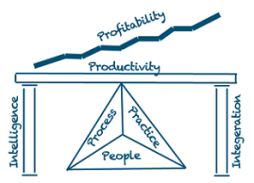The Secret To Implementing Effective Business Analytics (BA)
January 30, 2012 2 Comments
 Business Intelligence (BI) and Data Analytics are surely gaining higher importance with the businesses worldwide. Importance of data mining and data enriching have never been felt more strongly before with zetabytes of data being created every day from various sources such as social media platforms and mobile devices. Considering BI and data analytics as pre-requisites for Business Analytics (BA), it is clear that the discipline of Business Analytics will catch more prominence as a practice in the corporates.
Business Intelligence (BI) and Data Analytics are surely gaining higher importance with the businesses worldwide. Importance of data mining and data enriching have never been felt more strongly before with zetabytes of data being created every day from various sources such as social media platforms and mobile devices. Considering BI and data analytics as pre-requisites for Business Analytics (BA), it is clear that the discipline of Business Analytics will catch more prominence as a practice in the corporates.
With the cloud computing as the next norm in IT, access to business analytics services will also be demanded in the cloud. The convergence of large data warehouses and business intelligence tools and processes is inevitable. But the question is, is Cloud Business Analytics already a mainstream? If not, then what do current trends say about its future?
Evolution of Business Analytics as a Practice
According to a research program conducted by Bloomberg Business Research Services in May 2011 (and as published by SAS in a whitepaper – The Current State of Business Analytics: Where Do We Go From Here?), some observations stand out and throw light on very important aspects of BA in organizations. One of the important insights is that BA remains in emerging state as far as using the technological tools effectively is concerned. Though as a discipline BA has gone mainstream, but many organizations still use traditional technology tools, Spreadsheets being the most common. Those organizations who do use more sophisticated tools do not know how to apply the results. Moreover, many organizations find it difficult to get proper talent for analytics.
Higher acceptance is seen by large enterprises. But the preference for BA is growing. According to a report by International Data Corporation (IDC), the world business intelligence (BI) tools market generated more than $4 billion in revenues in second half of 2010. For the same year, BI tools market grew by 12.7% year on year. Though the growth rate may seem modest, but it is the first time that the BI tools market has surpassed the $4 billion mark in six months itself. BI tools being the pre-requisite technology for enabling better and complete application of BA, the report by IDC indicates bright prospects for the BA market worldwide through the next five years. BA was reportedly one of the top IT priorities in 2011 for most organizations.
Why in the Cloud?
Biren Gandhi in an article – Cloud: A Catalyst for Commoditization of Business Analytics, has written that BA today is about creating value at the intersection of multiple business domains for business optimization and to derive sustained competitive advantages in the marketplace. Though organizations are sold on the importance of practicing BA for better business performance, but to move from just managing business domains to getting better business insight and planning for reducing costs has many roadblocks. Those who do use BA may not be getting ‘effective’ results out of it because of roadblocks such as lack of maturity of BA tools itself or high cost of owning them.
In the research program conducted by Bloomberg Business Research Services in May 2011, it was found that 51% of the respondents found the use of business analytics as somewhat effective. This can easily lead to the inference that either the tools are not mature (and hence not effective enough) or the the cost of adopting and provisioning new tools based on business needs are high. The BA tools vendors can plug the market gap by providing BA solutions in the cloud. Cloud can actually act as a catalyst for meeting the growing demand for BA as a discipline while keeping operating costs low for the customer organizations. Top BI tools vendors such as IBM, SAP and Oracle can add great value if they host their applications in the cloud. This will greatly facilitate better access to information across the organization and will not confine BA process and the resultant information within the functions or departments.
As always, we would love to hear your thoughts on this. Please share.
IMAGE SOURCE: http://www.computerweekly.com/blogs/open-source-insider/2010/10/open-source-business-intelligence-on-the-mobile-map.html



